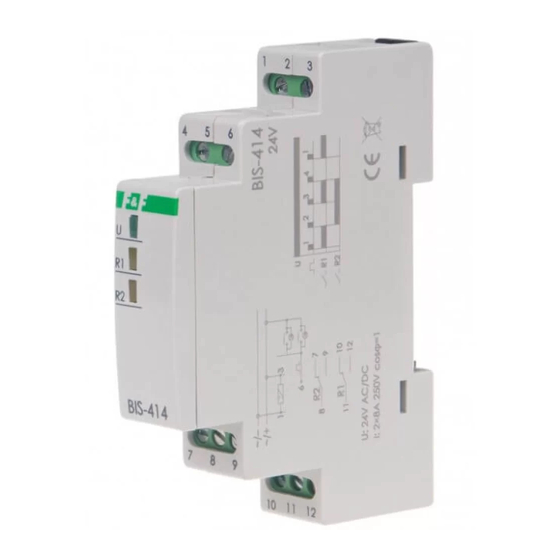
Advertisement
Table of Contents
BIS-414
Bistable relay,
sequential, 1-function
Do not dispose of this device in the trash along with other waste! According to the Law on
Waste, electro coming from households free of charge and can give any amount to up to
that end point of collecti on, as well as to store the occasion of the purchase of new equip-
ment (in accordance with the principle of old-for-new, regardless of brand). Electro thrown
in the trash or abandoned in nature, pose a threat to the environment and human health.
Purpose
The electronic bistable pulse relay BIS-414 allows lighting or other
appliances to be switched on or off from several different points by
means of parallel connected momentary (bell) control switches.
The relay has 2 switching sections and allows to switch on or off
in sequence 2 lighting circuits or other appliances from several
different points.
Functioning
Power supply to the relay is indicated by the lighting of the green
LED [U]. The sequential relay has 2 separate outputs R1 and R2.
The state of the contacts (closed/open) is enforced sequentially
according to the preset programme. Switching of the contacts to
the next state takes place after another impulse of the control
button. Activation of contacts R1 and R2 is signalled by lighting
of corresponding red LEDs R1 and R2. After the power supply
voltage decay, the contact status is reset. After the power supply
voltage is restored, the relay starts from sequence no. 0.
F&F Filipowski L.P.
Konstantynowska 79/81, 95-200 Pabianice, POLAND
phone/fax (+48 42) 215 23 83 / (+48 42) 227 09 71
www.fif.com.pl; e-mail: biuro@fif.com.pl
- 1 -
Advertisement
Table of Contents

Summary of Contents for F&F BIS-414
- Page 1 Purpose The electronic bistable pulse relay BIS-414 allows lighting or other appliances to be switched on or off from several different points by means of parallel connected momentary (bell) control switches.
- Page 2 Sequence Contact position Sections R1 and R2 open Only section R1 closed Only section R2 closed Sections R1 and R2 closed Subsequent pressings of a bu on repeat the sequence 0-1-2-3. - 2 -...
-
Page 3: Contact Configuration
6 and the wire to which terminal 3 is connected. 5. Connect the powered receiver of section R1 in series to termi- nals 11-12 and the receiver of section R2 in series to terminals 8-9.. BIS-414 is compatible with backlit buttons. Contact configuration - 3 -... -
Page 4: Wiring Diagram
Wiring diagram relay power supply 165÷265 V AC control input output 2 – NC contact (passive) input 2 – COM contact power supply output 2 – NO contact (active) output 1 – NC contact (passive) input 1 – COM contact power supply output 1 –... - Page 5 relay power supply 165÷265 V AC control input output 2 – NC contact (passive) input 2 – COM contact power supply output 2 – NO contact (active) output 1 – NC contact (passive) input 1 – COM contact power supply output 1 –...
- Page 6 The maximum total backlight current of all connected buttons must not exceed 5 mA. Technical data power supply 165÷265 V AC contact separated 2×NO/NC maximum load current (AC-1) 2×16 A control pulse current <1 mA total backlight current control buttons 5 mA activation delay 0.1÷0.2 s...
-
Page 7: Power Table
Power table Table for loads supplied with 230 V AC: tungsten halogen fluorescent energy-saving 2000 W 1250 W 1000 W 500 W 250 W The above data are indicative and will heavily depend on the design of a specific receiver (that is especially important for LED bulbs, energy-saving lamps, electronic transformers and pulse power supply units), switching frequency and operating conditions.














Need help?
Do you have a question about the BIS-414 and is the answer not in the manual?
Questions and answers